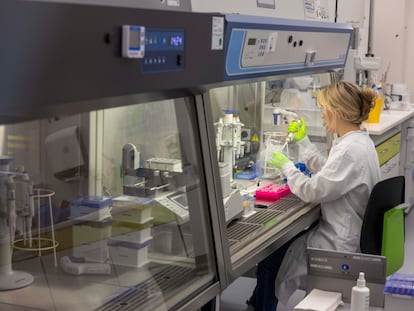Two drugs that activate human defenses improve the prognosis for those with deadly skin cancer
The combination of a pair of drugs ‘awarded’ the Nobel Prize in Medicine reduces tumors in 28% of patients with aggressive melanoma

In 1992, Japanese scientist Tasuku Honjo made a revolutionary discovery, a human protein that acts as a brake on the body’s defenses called PD-1. By removing this blockage with a drug called nivolumab, the immune system can more fiercely attack cancer cells. The winner of the Nobel Prize for Medicine five years ago, Honjo himself estimates that the drug has probably saved the lives of hundreds of thousands of people since its approval in 2014. Nivolumab is already authorized for use in a multitude of cancers, such as skin, lung, kidney, bladder and liver cancers — but it is not a panacea. Over half the cases of metastatic melanoma are resistant to the drug. This Thursday, a scientific team headed by physician Antoni Ribas, introduced a new strategy for fighting cancer.
Honjo shared the Nobel Prize with James Allison, the American researcher who identified another protein that acts as a brake on the body’s defenses — CTLA-4 — in 1996. Approved in 2011, the drug ipilimumab deactivates that brake, allowing white blood cells to attack the tumor in thrombus. The usual treatment for advanced metastatic melanoma — the most aggressive form of skin cancer — is PD-1 inhibitors, like nivolumab. If there is resistance to the drug, the second option is usually CTLA-4 inhibitors, such as ipilimumab. Honjo and Allison are the fathers of immunotherapy, the treatment that uses the patient’s own defenses to fight cancer. Antoni Ribas’s team has investigated the efficacy of combining these two revolutionary drugs.
Ribas is the director of the Tumor Immunology Program at the Jonsson Comprehensive Cancer Center at the University of California, Los Angeles. His team selected 91 patients with deadly melanoma who did not respond to the first PD-1 inhibitor treatment. Sixty-eight of them went on to receive the combination of nivolumab and ipilimumab, while the other 23 were given ipilimumab alone. The results of the study, published in the journal Nature Medicine on Thursday, show that the tumor shrank in 28% of the participants who took the combination treatment, compared to only 9% of those who received ipilimumab alone. Survival without disease progression increased by 37%.
Studied in only 91 patients, the findings are preliminary, but Ribas is optimistic that these results could change current clinical practices. In his view, the combination strategy should be the preferred option for people with cancer who have not responded to the first immunotherapy treatment. However, this drug cocktail is more toxic. Fifty percent of patients suffered significant adverse effects, especially diarrhea, as compared with 22% of those who received ipilimumab alone.
“In many parts of the world, this combination was given to all patients right away, but the problem is that 50% of patients don’t tolerate it because of toxicities. We can say that this is a change in clinical practice because we see that it is better to give a PD-1 inhibitor drug up front. Patients who respond to it are spared the combination’s toxicities and, among those who do not respond, one-third benefit from receiving the combination afterward,” Ribas explains.
Melanoma originates in melanocytes, the cells that produce melanin, the pigment that colors the skin. The tumor usually appears in the areas of the body that are most exposed to the sun in people who work outdoors or who have simply experienced sunburn at the beach or the swimming pool. According to data from the International Agency for Research on Cancer, some 325,000 cases are diagnosed worldwide each year, causing 57,000 deaths per year.
Nivolumab and ipilimumab end in the syllable “-mab” because they are monoclonal antibodies, proteins designed in the laboratory to recognize and bind to other proteins. In the second quarter of 2023 alone, U.S. drugmaker Bristol Myers Squibb earned about $2,136,023,775 (€1.965 billion) from sales of nivolumab, marketed as Opdivo, and $581,625,250 (€535 million) from ipilimumab, sold as Yervoy, according to company data. Antoni Ribas’s study was funded by the National Cancer Institute and the National Institutes of Health (NIH) in the United States.
Ribas himself predicted this future, in an article published in EL PAÍS in 2015, in which he talked about PD-1 and CTLA-4 inhibitor drugs. “What we needed to do was not give vaccines or other treatments to activate the immune system, but to take away the inhibitory mechanisms that prevent it from killing tumor cells,” Ribas argued. “We are understanding why some patients respond to this treatment and others do not, which allows us to believe that we will be able to develop drug combinations that will benefit a greater number of patients and tumors,” he predicted.
Oncologist Iván Márquez, of the Gregorio Marañón Hospital in Madrid, Spain, applauds the new study but points out its limitations. “It is an academic study that does not have the muscle of the pharmaceutical industry behind it, but it does shed light on a very important question: what to offer patients for whom the best available treatment does not work,” he says. Márquez emphasizes that fewer than 100 patients were studied, so the research “does not have the statistical power” to show whether the combination of drugs really helps the patients live longer. “The combination of nivolumab and ipilimumab is more toxic than ipilimumab alone. You’re putting patients at greater risk of toxicity without increased survival or increased quality of life in return. There is no evidence of that here because it has not been analyzed,” says the researcher, who is also a spokesman for the Spanish Society of Medical Oncology.
Márquez also points to “a regulatory problem,” since the European Medicines Agency authorizes the combination of nivolumab and ipilimumab as a first-line treatment for melanoma, but public funding in Spain only covers three subgroups of patients, like those with brain metastases. “It is not a definitive solution. There are many, many trials underway that are exploring other types of combinations,” adds Márquez. “Do these new results change clinical practice? Well, they at least shed light on the fact that, if you want to choose between the two options, choosing the combination could guarantee a little more time for patients to control the disease,” says the oncologist.
Sign up for our weekly newsletter to get more English-language news coverage from EL PAÍS USA Edition
Tu suscripción se está usando en otro dispositivo
¿Quieres añadir otro usuario a tu suscripción?
Si continúas leyendo en este dispositivo, no se podrá leer en el otro.
FlechaTu suscripción se está usando en otro dispositivo y solo puedes acceder a EL PAÍS desde un dispositivo a la vez.
Si quieres compartir tu cuenta, cambia tu suscripción a la modalidad Premium, así podrás añadir otro usuario. Cada uno accederá con su propia cuenta de email, lo que os permitirá personalizar vuestra experiencia en EL PAÍS.
¿Tienes una suscripción de empresa? Accede aquí para contratar más cuentas.
En el caso de no saber quién está usando tu cuenta, te recomendamos cambiar tu contraseña aquí.
Si decides continuar compartiendo tu cuenta, este mensaje se mostrará en tu dispositivo y en el de la otra persona que está usando tu cuenta de forma indefinida, afectando a tu experiencia de lectura. Puedes consultar aquí los términos y condiciones de la suscripción digital.
More information
Archived In
Últimas noticias
Most viewed
- Sinaloa Cartel war is taking its toll on Los Chapitos
- Reinhard Genzel, Nobel laureate in physics: ‘One-minute videos will never give you the truth’
- Oona Chaplin: ‘I told James Cameron that I was living in a treehouse and starting a permaculture project with a friend’
- Why the price of coffee has skyrocketed: from Brazilian plantations to specialty coffee houses
- David King, chemist: ‘There are scientists studying how to cool the planet; nobody should stop these experiments from happening’











































